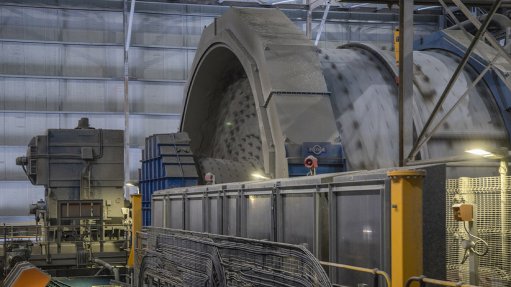
Zest WEG’s customised mill drive solutions include special features for mill operations, such as frozen charge detection software
Photo by: Zest WEG
Local electrical equipment manufacturer Zest WEG offers extensive applications knowledge, underpinned by its local capabilities, to customers across a range of industries. Adding value to its large range of electric equipment, Zest WEG has in its offering, customised solutions designed to suit specific customer application requirements.
“We have developed and supplied customised variable-speed drive (VSD) application solutions which offer unique benefits to our clients. Some examples include a tailor-made software for mill applications, a master-follower solution for torque sharing applications, as well as a custom solution providing multi-voltage output for test-bay applications,” explains Zest WEG engineering and projects senior manager Kirk Moss.
Zest WEG’s customised mill drive solutions include special features for mill operations, such as frozen charge detection software, which allows for the objective determination of charge cascading using torque and mill angle measurements.
Moss says that frozen charge detection software enables the VSD to objectively determine if there is a frozen charge in the mill during startup.
“We use this special programming to monitor certain variables in the mill drive such as torque and angle. Using this torque and angle information, and comparing it to expected setpoints, we are able to determine if the mill has a frozen charge or not,” he says.
Moss says Zest WEG has vast experience in mill applications, as it has performed many variations of solutions in this area. These include high speed asynchronous motor systems with gearbox, low speed synchronous motor systems without gearbox, as well these same two main systems in both single and dual pinion arrangement, with and without speed control.
Zest WEG has also developed master-follower solutions, where load-sharing among several VSDs driving the same load is required. The VSDs share the load evenly using intelligence either through software or through hardwired signals.
“Even if there is a difference in the mechanical drive trains of motors driving the same load, the VSDs communicate between each other and ensure equal load-sharing within a specified bandwidth of torque or speed,” notes Moss.
Zest WEG has supplied many such solutions, including large conveyor belts with multiple drives on the same pulley as well as on distinct pulleys, high-pressure grinding roll crushers and load-sharing dual pinion mills.
The master follower solution can be applied using Zest WEG standard parameters where customised software is not required, or using customised software on more complex applications.
Where customised control is required, Zest WEG uses a programmable logic controller (PLC) function in the form of a built-in soft PLC which comes standard in most Zest WEG VSDs or can be added as an additional option-card. WEG ladder programmer, WEG’s proprietary programming software, is available free of charge on the Zest WEG website and can be used to create and download programs to the VSD’s PLC.
“Clients familiar with basic ladder programming principles are able to use this powerful tool themselves and incorporate some special application logic of their own design to their WEG VSD systems,” Moss points out.
Adding to the array of application specific solutions, Zest WEG recently installed and commissioned its specialised solution for a test bay application at a national pump testing facility for a leading pump company.
The programme enables the client to test pump sets of different voltages using the same VSD without making any hardwire power cable or busbar connection changes. This presents a significant safety benefit.
Users can install and test motors ranging from 690 V to 11 kV by simply pushing a button on the touch screen human-machine interface. The VSD is able to automatically adjust its output voltage to that of the motor being tested.
“This is very convenient for the client because it does not require leaving the control room to change the voltage output of the VSD. The main advantage is that there is no output transformer needed to make these voltage changes – it is all done in the software and the hardware of the VSD,” concludes Moss.